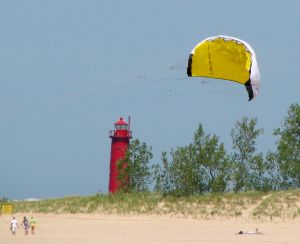How Do I Learn to Kiteboard?
Learning to kiteboard consists of three initial steps:
 Learn to fly a two line / four line kite. No matter how strong your board skills are, they are useless until you learn how to fly a kite. Trainer kites are small two line / four line kites which allow you to practice the basic flying skills necessary to kiteboard, without investing in or damaging a full size kiteboarding kite. Buy or rent a trainer and spend 4-10 hours flying the kite prior to your next step.
Learn to fly a two line / four line kite. No matter how strong your board skills are, they are useless until you learn how to fly a kite. Trainer kites are small two line / four line kites which allow you to practice the basic flying skills necessary to kiteboard, without investing in or damaging a full size kiteboarding kite. Buy or rent a trainer and spend 4-10 hours flying the kite prior to your next step.- Take a lesson. Kiteboarding isn't something you can pick up in a afternoon using a friend's kite. There are specific skills you must learn prior to even getting the kite off the ground or in the water. Would you learn to Scuba Dive or Sky Dive without a lesson? What would happen if you put up a kite in too much wind, or how do you re-launch the kite once in the water? Those topics and many others are covered in depth during a kiteboarding lesson. Also, during lessons you are using the school's gear, so you don't end up damaging your new investment.
- Buy kiteboarding gear. You now know the concepts needed; it's time to get out and build your own skills. We help each customer choose a kite, board, harness, and any other accessories and make certain that it fits their needs. What works for a 120 pound teenager won't do much good for a 260 pound adult. Let your local kite surf shop help educate you.
Time frame?
This is something that we can't forecast 100%. Each new student has different levels of kite and board experience, and some people simply learn to kiteboard faster.
| PASA Equivalent | Step: | Time Line: |
| Level 1 Kiteboarder | 1. Learn to fly a trainer | Prior to lesson, spend 5-10 hours |
| 2. Learn to set up, launch, land, and fly inflatable kite. | Camp Day 1 | |
| 3. Learn to relaunch, self rescue, and body drag. | Camp Day 2, and 5 or more sessions with your own gear. | |
| Level 2 Kiteboarder | 4. Learn to waterstart. | Covered during Camp Day 2. Work really begins at session 6. |
| 5. Learn to ride. | Begins immediately after your first waterstart. Session 6-10. | |
| 6. Learn to do transitions. | Early transitions are simply waterstarts, but as you get better you will ride through the turn. Session 6 and up...you never stop learning new ways to turn around. | |
| Level 3 Kiteboarder | 7. Going upwind. | 20-30 sessions. From here on out you no longer end up downwind of where you put in. As you get better, you'll be able to tack into the wind at up to 45 degrees. |
| 8. Jumping. | 20-30 sessions. You'll likely catch a little air even before you begin to stay upwind reliably. | |
| 9. Boosting. | 30+ sessions. This is why most of us love the sport, by timing a simple edge and pop jump with redirecting the kite, we use the kite's power to send us 10-30 feet up... |
Continue to 'The Wind Window'
Return to the Kiteboarding Knowledge Center
1st Jan 2010
Recent Posts
-
Kiteboarding | Crafting the Harlem Force Kite with Sustainability and Performance
Unparalleled Performance Meets Unmatched Sustainability The kiteboarding industry is on …24th Apr 2024 -
Duotone Ventis 2025 | What's New?
If you're familiar with Duotone's Ventis, you know its specialty is freeriding in light wind …23rd Apr 2024 -
Duotone Ventis D/LAB 2025 Overview
If you ride in an area with multiple light wind days and need a wing that'll let you get o …23rd Apr 2024



